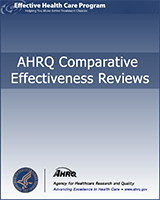NCBI Bookshelf. A service of the National Library of Medicine, National Institutes of Health.
Ip S, Terasawa T, Balk EM, et al. Comparative Effectiveness of Radiofrequency Catheter Ablation for Atrial Fibrillation [Internet]. Rockville (MD): Agency for Healthcare Research and Quality (US); 2009 Jul. (Comparative Effectiveness Reviews, No. 15.)
This publication is provided for historical reference only and the information may be out of date.

Comparative Effectiveness of Radiofrequency Catheter Ablation for Atrial Fibrillation [Internet].
Show detailsRFA was superior to medical treatments at maintaining sinus rhythm in patients with PAF who failed first-line medical treatment over 1 year of followup. It should be noted that the primary endpoint in all published RCTs to date has been the recurrence of AF and no RCT has examined the effect of catheter ablation on the risk of stroke or death. To fully comprehend outcomes like stroke, death, or quality of life, much longer followup will be needed.
Studies reported different approaches to followup evaluations and treatments for recurrent AF: some used Holter monitoring to assess for asymptomatic AF recurrence, some relied only on symptomatic AF recurrence; some outcome assessments reported aggregate data including reablation (but did not report separate data on those without reablation); some outcome assessments reported aggregate data from both patients who were on and patients who were off AADs (but did not segregate the data respectively). These differences in followup monitoring and management across studies limit the comparability across studies and hamper our ability to assess the true effect of RFA. Future studies should strive to adopt standardized post-RFA monitoring including taking advantage of modalities that would be more sensitive to asymptomatic recurrences of AF (e.g., event monitors, implantable loop recorders, or existing pacemakers). In addition, followup durations longer than the typical 6 to 12 months observed in the current literature are needed before more reliable inferences could be made concerning longer-term efficacy of this procedure. Moreover, to further understand why some patients benefit from RFA and some do not, a uniform system of defining the various types of AF and conditions under which outcomes were evaluated (e.g., on or off AADs, after one or more than one ablation, symptomatic or asymptomatic AF outcomes, with or without Holter recordings) should be implemented in future studies.
Only one small RCT suggested that first-line RFA (prior to a trial of AADs) may be of benefit for patients with less than 3 months of AF, further studies are needed to confirm this finding.
Whether the AF type is predictive of a higher rate of AF recurrence after RFA is still unsettled. Data from a large registry of patients with uniformly defined AF types and AF recurrence outcomes may help improve future analyses examining this important question.
Even though major adverse events were uncommonly reported in the studies reviewed, serious and life-threatening events (e.g., atrioesophageal fistula) do happen. Studies on identifying the patients who are most likely to benefit from RFA and studies on different RFA approaches and techniques to improve efficacies and minimize complications should be undertaken. Furthermore, adverse events should be uniformly defined so that informative comparative analyses could be performed.
Further investigations are also needed on the effect of RFA for AF on quality of life, including in patient population under-represented in the current literature but often encountered in clinical practice (e.g., the elderly, women, those with very low EF or enlarged LAD, and patients with multiple comorbidities).
- Remaining Issues and Future Research - Comparative Effectiveness of Radiofrequen...Remaining Issues and Future Research - Comparative Effectiveness of Radiofrequency Catheter Ablation for Atrial Fibrillation
Your browsing activity is empty.
Activity recording is turned off.
See more...